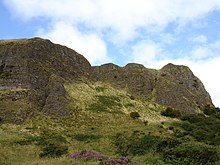Cavehill
The approximately 370 m high Cavehill also Cave Hill or Ben Madigan, ( Irish Beann Uamha or Beann Madadháin ), a basalt mountain on the outskirts of Belfast in Northern Ireland , was visited by people 9,000 years ago. However, the tracks have been covered by peat and heather for the past 2000 years.
The cairn
At the top of Cave Hill is a large Neolithic cairn about 16.0 m in diameter and 1.15 m high, which is almost entirely covered by peat.
Ballyaghagan Cashel
Near the entrance to the "Cave Hill Country Park" on Hightown Road, there is a cashel with a curtain wall of about 40.0 m in diameter made of dry stone . Inside there is a rectangular structure of around 9.0 × 12.0 m, which may be a later addition. The remains are believed to date from the 8th century. Ballyaghagan Cashel is a Scheduled Historic Monument .
McArts Fort
Little is known historically about McArts Fort. It has a diameter of about 50 m and is surrounded by an earth wall and ditch that has been eroded by road construction and natural processes. Despite its name, it cannot have been a fortification as it is too small and has no water supply. Instead, it is believed to have had a ritual purpose in the Neolithic. There is evidence that McArt's fort was damaged by vandalism by treasure hunters.
The caves
The five caves were described in detail in the "Ulster Journal of Archeology" in 1902. Little is known since they are artificial but nothing has been found in them.
Crannóg
The remains of a crannóg on the grounds of Belfast Zoo have been covered with earth. When the zoo grounds were created, the dry lake was restored. It was decided to change the structure of the Crannógs, which was probably built in the late Bronze Age between 1500 and 500 BC. Belongs to preserve for future archaeological excavations.
Rath and basement
In 1947, workers in Shaneen Park, off Upper Cave Hill Road, discovered a Rath and a basement . Excavator E. Estyn Evans believes it dates to around AD 900. The subsequent excavation in 1958 revealed a second period of use in the 12th or 13th century. The Rath is about 30 m wide and is located on private land.
Small finds
In 1993 a golden fibula was found on the side of a gravel path to the summit. In a three-day excavation, the Ulster Museum found that it dates from 1000 to 700 BC. Belongs to. This excavation also uncovered an early medieval hearth about 30 cm from the fibula. Artifacts from the Neolithic Age and early medieval ceramics have been found.
See also
literature
- Philip Reynolds, Samuel Turner: The Caves in Ben Madighan. In: Ulster Journal of Archeology. Series 2, Vol. 8, No. 2, 1902, ISSN 0082-7355 , pp. 73-82, JSTOR 20566077 .
- E. Estyn Evans: Rath and Basement at Shaneen Park, Belfast, Townland of Ballyaghagan, Co. Antrim. In: Ulster Journal of Archeology. Series 3, Vol. 13, 1950, pp. 6-27, JSTOR 20566589 .
Web links
Coordinates: 54 ° 38 '49.2 " N , 5 ° 57' 3.6" W.

